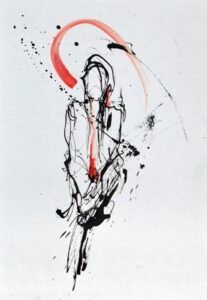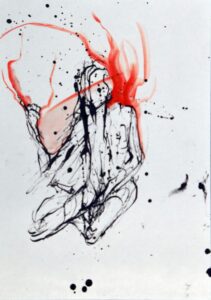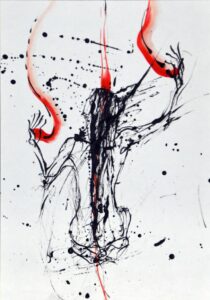Creation (Upd: Mar 26, ’23)
What a privilege it is to be alive because we can create!
As a prequel to begin the process of creation, we must have curiosity to begin with. To Yukio Waguri, we must have “optimistic irresponsibility” for exploration. That is, one must, in Helena Kantinkoski’s words, “be interested in what one does not understand, and rather become tired of the things one already has understood.”17 In short, be obsecure.
Another important note to put in is that you get out what you put in. To swim, you must get in the water. To dance you must use your body. This is the fieldwork, and the field is your body.
Butoh scholar P Liao breaks down the creative process of butoh into three parts: (1) Emptying; (2) Encountering; (3) Transforming.² To this manual, these 3 parts are not a hierarchy but a holoarchy, as in, the successor includes and integrates with the predecessor. The 3 steps are equally important. Together they form creation.
1. Emptying/Quieting (Via Negativa)
“Just as sound is born of silence, calm envelops all movement. The being within the total void allows the body to discover the new strings which will move it.” – Viala J and Masson-Sekine¹
The bowl empties.
We become a transparent or empty body so that qualias can enter freely. The body grows quiet. The ego grows quiet. Nurture happens. No ease is dis-ease. There is peace or cremation/surrender. Rest in peace. The body without organs (BwO) is the same concept, coined by Antonin Artaud.
P Liao notes, “with the metaphor of the cremation of the body, Hijikata implies that the body has to cease being itself, that is, no longer being the dancer’s body, so that other kinds of imagery of the world can use the body to present themselves.”² In Hijikata’s words:

Butoh is an external vessel of emptying and refilling. The subject and object coexist in a state of trance. The moment the vessel is brimfully filled up, it (a sort of spirituality) overflows out of it. Just after that it will be intruded and refilled.12
In the book The Intimate Act of Choreography, this concept of emptying is called neutrality.23
Adding on to this concept, Sondra Fraleigh mentions, “Admitting gravity and letting go of expectations, we may find that grace is indestructible, that we can trust our attention to odd juxtapositions, for life will surely bring the unexpected.”6 In other words, emptying or surrendering is the opening up the set and setting that will allow for creation. This especially includes limitations which themselves can serve as a big springboard to creation.
The term via negativa was coined by Jersy Grotowski which meant “to eliminate from the creative process the resistances and obstacles caused by one’s own organism, both physical and psychic (the two forming a whole).”22
A Cup of Tea is a popular koan directly related to the idea of emptying: “Like this cup,” Nan-in said, “you are full of your own opinions and speculations. How can I show you Zen unless you first empty your cup?”
Emptying/Quieting is also the second pillar for Akaji Maro’s (founder of Dairakudakan) creation process known as Maro’s Method, which is initial “Igata” of three pillars: (1) Teburi/Miburi (Purposeless Movement); (2) Igata (Mould); (3) Chūtai (Space-Body).8
In the initial Igata, the first mould/container/shell is the now space, emptiness, and ma. Externally, it is a frozen state. Maru calls this space “the gateway to the Butoh world.” He states further, “In this moment all thought is momentarily suspended in a void.
The idea is to maintain this state for as long as possible until something ventures out of the darkness to inhabit the body. “[…] It becomes a kind of ‘falling into’ the state of nothingness, quite suddenly – from a moment of shock or fright [see Teburi/Miburi].”8
Paradox: Being a nought when you are a something.
To contemporary metaphor theory, we would be at the image schema known as REMOVAL OF RESTRAINT, which to the SIL International Glossary of Linguistic terms is “the physical or metaphorical removal of a barrier to the action of a force or absence of a barrier that was potentially present.18 Emptying/Quieting is a removal of whatever is restraining one from creation.
2. Encountering/Child Mind (“Yes”)
Matthew 18:3: “Truly, I say to you, unless you turn and become like children, you will never enter the kingdom of heaven.”
The empty bowl can now let something in.
This is the “yes” of the improvisational theatre “yes, and,” and possibly even the “Yes” in Yeshua (Hebrew for Jesus). This step is resonance and presence or presonance.
In P. Liao’s words “Encountering is the way in which a dancer initially acquires a perception of the surrounding environment. Ohno explains that to encounter a situation within an environment is to live through the situation at that very moment without being influenced by habits, preconceptions, or any intellectual considerations, thereby exploring the situation afresh and acquiring a perception of the world.”³ In other words, , “encountering is understood as being made through the empty body interacting with stimuli, movement, and memories.”4

To the Zen master Shenxiu, this may be seeing with a clean mirror. When we really see or really listen, it may be as if we as an individual forget we exist. This is what Nishida Kitarō calls pure experiencing or intuiting.
To the Maro Method, this would still reside in the initial Igata (mould). Maro cites this stage as “the surprised laughter of a Zen Buddhist monk when watching the full moon suddenly disappear behind a cloud, or a baby’s excited gasp when it witnesses a rolling chopstick for the first time.”
We are rechilding.
Lynn Bradley further mentions, “Instead of trying to instantly make meaning of the event, as adults tend to do, Maro encourages suspending this moment in a state of ‘no meaning’ with other less obvious ‘accidents’ given as examples including discovering a grey hair whilst brushing your hair, or realising a page is missing from a favourite book you are reading.”8
One becomes sensitive and aware. One reaches what Tatsumi Hijikata and Yoshito Ohno both called delicacy where tiny details are noticed such as a tiny cut on the finger.14 We must become walking antennas. Resonance artists.
To Yoko Ishikawa, this is the state of felt imagery, but can only be reached after getting past the stumbling block of mere visualization (solely visual channel engaged). The desired state is internalization.16
To Contemporary Metaphor Theory, encountering would be an ENABLEMENT image schema, which provides the means for an agent or entity to move in a desired place,19 or as Aleksander Szwedeck notes, a “complex schema consisting of removal of restraint resulting in ability.”20
3. Transforming/Creating (“And”)
“I hold that butoh is most basically a metamorphic form of dance, and it is so in several ways. A primary means of butoh training is through the streaming or morphing of images ever in the process of change.” – Sondra Fraleigh7
This is the “and” of the improvisational theatre “yes, and.” This step is improvisation.
Creation is the goal. With all the conditions being set, we create/transform, (or as Hijikata humbly and/or bouffonesquely mentioned) we generate fake things.
To Liao P, “transforming is understood as being completed through arriving at a state of resonance between the bodily posture, gesture, movement, and the image to be transformed.”4 Take a space, as Liao P notes, in transforming, the body will merge with the space and create a personal space. The natural result are personal images within the space that take you.5
These images can be seen as qualias. With a clean mirror, we can then see what qualias emerge, or, ‘pataphorically speaking, we can turn the mirror around and see what lurks behind.

Transformation is resonance. What is resonance? In physics, resonance is when a vibrating system or external force drives another system to oscillate with greater amplitude at specific frequencies. The phenomenon happens, for instance, when we match somebody’s tune. Resonance is becoming in-tune. To bhakti yogins, resonance is love itself.
To Deleuze and Gauttari, resonance is a becoming and there is always something to become (just as there is always an affect). To D & G, “a becoming is not a correspondence between relations. But neither is it a resemblance, an imitation, or, at the limit, an identification.”10 In other words, a becoming is not merely miming or imitating a qualia, nor is it identifying as something (I am this or that), but something else altogether. Qualialization instead of visualization. One can perhaps think of a spirit, e.g. a totem entering or possession. The spirit of any and everything is its qualia. Transformation is resonance and becoming-a-qualia.
Transmutation, sublimation, catharsis, recontextualization, ‘pataphorication, reduction and regeneration, remix, and play can all be forms of this transforming. It can also be the “Kyu” to the Jo-Ha-Kyu. To Stanislavski, the word if can lift us out of the ordinary world, which is a means for reduction/regeneration/edit, e.g. If my organs turned into marbles, then?11
To the Maro Method, transformation would involve both the second pillar Igata (mould) followed by the third pillar Chūtai (Space-Body). While still in Igata, the body from its empty mould becomes various other moulds as if he/she/they were possessed, while at the same time, keeping the initial moulde of stillness.9 This bares resemblance to Tatsumi Hijikata’s vaporized body.
In Maro’s words: “It’s as if the gods have told you not to move, but you are a naughty child disobeying your mother and trying to find opportunities to transgress, whilst still keeping the restriction or tension present.9
Then the third pillar comes into play, the Chūtai (Space-Body), and the boundaries dissolve or become porous, allowing for the ma or space to invade.9 Here is where the body may appear to have broken out of the moulde and is being moved by forces all around, and outside merges with inside.
Natsu Nakajima sums up the creative process of butoh in just two steps: Becoming nothing. Becoming something.13
Hijikata called the ultimate butoh state Hoopee. Rhizome Lee notes: “Hoopee is the most ideal dancing body for Hijikata which is able to dance beyond all boundaries flexibly with transforming freely as the Shisha (Dead).”15
To Contemporary Metaphor Theory, conceptual metaphors (universal metaphors) for creation include birthing and cultivation: CREATION IS BIRTHING & CREATION IS CULTIVATION. Examples given by George Lakoff: “This solution actually gives birth to a lot of new problems;” and “He planted seeds of doubt in my mind.”21 Perhaps it serves well to enter into qualia-world of birthing or cultivation?
Pre-movement Meditation
As do some athletes, it is recommended to incorporate dancing while externally keeping a stillness meditation (the position can be any comfortable position, not just lotus or seiza). This can also be performed while serving as an audience member and seeing yourself as an additional participant.
Creation/Experience Journal
To Hijikata, butoh was a way of life. Even after rehearsal, butoh life commenced. It is highly recommended to consistently keep some sort of journal, if not multiple ones. Hijikata resonated heavily with words, which is why he had so much butoh-fu (written butoh scores) and stream-of-consciousness sort of writings (e.g. Sick Dancing Princess). Here are some ideas: (1) dream journal; (2) trigger/edge/shadow journal (this is opening awareness to anything that does not resonate well (aka kan qualia); (3) after-class/research journal; (4) synchronicity journal.
